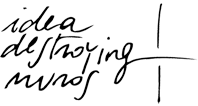UI FAK AUAR STORIS

12 diciembre - 12 enero 2014
ubik café calle litorato azorin 13
valencia
follar nuestras historias nos pone en la posición de buscarlas y de conocerlas, como se busca y se conoce alguien con quien se folla.
establecemos historias personales con los acontecimientos, los lugares y las políticas sociales que nos atraviesan, vienen con nosotras hasta en la cama.
en un contexto occidental donde el afecto es constantemente mediado por la explotación y la dominación, apostamos por desplazar el amor dentro de la traducción como práctica de resistencia contracapitalista y no como herramienta al servicio de la unión neoliberal europea.
además a través de las prácticas artísticas tocar la imaginación de las y de los demás y no solamente de una, de uno, de dos o de más amantes.
la historia del arte que aprendimos carecía muy a menudo de coordenadas históricas y geopolíticas. pensamos que se trata de una falta educativa deliberada, siendo útil sobretodo para la integración al sistema eurocéntrico de desarrollo capitalista, en cuanto sistema de producción aparentemente neutral que quiere ser universalmente válido.
en ui fak auar storis traducimos a través de la creación artística nuestros relatos, tanto de los cuerpos como de los lugares que vivimos.
al ser nuestras historias fronterizas a nivel geopolítico, lingüístico y sexual, confirman la banalidad de la historia oficial, tanto a nivel nacional como europeo.y por banalidad entendemos la superficialidad, los silencios y la neutralidad oficial que somete a todas las diásporas.
estudiamos bellas artes en venecia y nos hicimos conscientes del potencial de absorción del mercado occidental del arte, y durante mucho tiempo apostamos por prácticas y producciones menos comerciales o por otras formas de vehicular la visibilidad. sin embargo la necesidad de exponer surge de la urgencia de recuperar nuestro tiempo y emancipar nuestras economías de vida.
siendo la historia del arte un relato occidental homologador y posicionándonos nosotras en las fronteras, tanto reales cuanto imaginarias, ya no pensamos que el dinero corrompa el valor contracapitalista de lo que hacemos sino que nosotras decidimos de aprovecharnos de él en cuanto él nos ha explotado hasta ahora.
con ui fak auar storis apostamos por propuestas más objetuales que perduran en el tiempo, en contraste al consumo hasta de la vida misma impulsado por el capital y para ganar de una puta vez!
hemos empezado a exponer ocupando nuestros propios lugares de trabajo.
dejar los curros de hostelería, propios de los inmigrantes, en este momento de rediseño de los equilibrios en el contexto europeo, es apostar por la autodeterminación económica y, una vez más, por la potencia creativa.
esto significa no solo apostar por la creación artística como arma de emancipación económica colectiva sino también salir de una construcción capitalista que nos quiere dependientes a todos los niveles.
por ello creemos que realizar e imaginar otras formas individuales y colectivas de supervivencia económica es parte imprescindible del proceso artístico.
los lugares de ocio y entertainment encuentran deseables y aprovechables creaciones políticamente comprometidas, bajo una perspectiva que sigue fundándose en la explotación del trabajo, por eso esta exposición ahora mismo desafía los lugares de la cultura institucional.
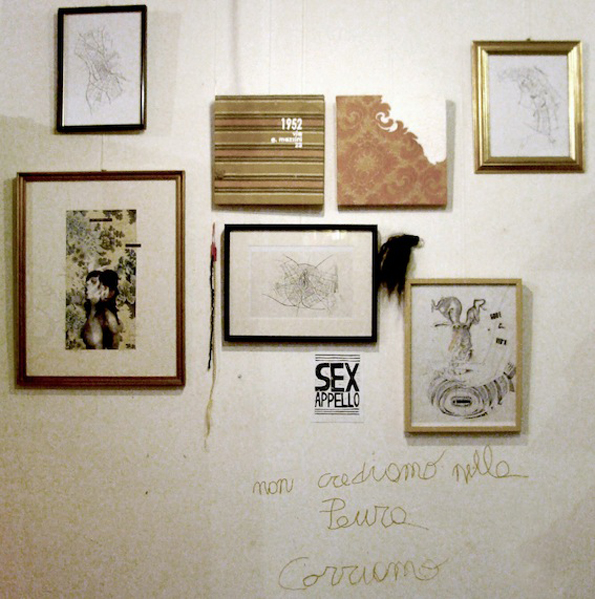
R EST
feminismo también significa asegurarse de que las energías vitales se transmitan entre generaciones y no sólo por una cuestión de sangre, sino por una lucha que transforma hasta las vidas de personas desconocidas. por eso el uso, como material artístico, de ropa de segunda mano de cualquier mujer, porque lleva los sueños de todas y el coraje, los olores, las expectativas, los silencios que permanecen en la tela.
la costura es una manera de utilizar una técnica que mi abuela, refugiada de istria, aprendió en la década de 1950 mientras vivía en el campo de refugiados de bari, en el sur de italia. la costura representó para ella la posibilidad de construirse una forma de trabajo autónomo, en casa y en negro. esto le ha permitido no estar ni sola en casa ni totalmente dependiente económicamente de los ingresos, en blanco, obtenidos por el trabajo fijo de su marido, él también refugiado. mi abuela para mí es una mujer negra, la historia de la diáspora de mi familia es una historia solo aparentemente blanca. yo soy hija mixta, he nacido entre el oeste y el este de europa durante los años de la guerra fría, y confío en las battonz, que han crecido en occidente, sólo cuando las percibo como diaspóricas.
lara bia utilizando la costura apuesta por la erradicación como una posición positiva. sexualiza el orden geopolítico para representar nuevas alianzas entre historias de diáspora y de frontera. juega con objetos inútiles capaces de (re)educar hacia la diversidad y conecta entre ellos a los cuerpos que una mirada arraigada prefiere ver como blancos y separados.
el collage era la única manera realmente útil de utilizar los periódicos italianos durante los años de berlusconi. a principio del 2000 la corrupción de los periódicos y de la televisión italiana era evidente, por lo tanto, nacen pequeñas resistencias diarias (el collage, la plantilla, pintarse el pelo entre otras) que luego formaron las prácticas artísticas y las resistencias estéticas que representan el imaginario de la nueva diáspora italiana de la cual nuestras historias forman parte.
berlusconi es el símbolo político de la forma de gobierno que ha hecho imposible nuestra permanencia en italia. el acto de abrir el periódico y de recortar la cara del presidente para luego pegarlo abajo de un cenicero de lo más barato, nos da la posibilidad de lograr unas pequeñas satisfacciones que se sitúan en el cotidiano y luego en el exilio. por último, frente a la ley anti-tabaco de homologación europea, crea una razón más para desobedecerles. se trata de una acción simple y repetible en contra de cualquier cargo que represente la misma corrupción política, democrática y decadente.
siendo en la europa occidental el individualismo, el éxito y la neutralidad unas herramientas capitalistas, me veo obligada a ganarle optando por un formato de exposición colectiva, feminista y situada en relación a clase, sexo, raza y procedencia.
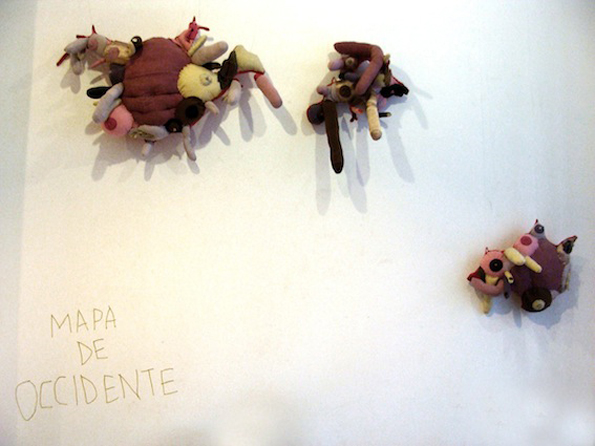
merisma - Bolge
La interpretación del modelo de la Bolgia vino de la lectura de un fragmento de la nota 71z de Petróleo, inacabada y última obra de Pier Paolo Pasolini. La descripción del modelo representado en el texto de las Bolge me pareció una figura interesante, ya que muestra la contradicción, la misma contradicción que he encontrado en relación con los deseos y las posibilidades en el contexto donde he vivido los últimos dos años en: valencia.
El proyecto de las Bolge nació para ser expuesto en las paredes del local donde trabajé durante 2 años como cocinera.
Hoy pienso que, el hecho de preparar comida y alimentar un mecanismo capitalista y consumista me generó un rechazo hacia mi misma.
El poco alimento procurado a nivel intelectual pasó a ser también físico como única forma de resistencia. De esta manera, esta serie de autorretratos "dobles" ha sido un reto hacia mi misma, hacia una recuperación de mi cuerpo en el cuidado, mis capacidades críticas y en una emancipación económica contra el trabajo y contra un sistema que anula.
El material utilizado es papel de pared que he encontrado en estos últimos años en valencia. Decidir utilizar este material ha sido provocado también para deshacerme de este cúmulo de cosas que guardo cuando estoy demasiado tiempo parada en un sitio, en una casa o en una ciudad. Los textos hacen referencia a la nota 71z de Petróleo y estan escritos con la mano izquierda, la que siempre he considerado la mano que no sabía escribir, por esto tiene más fuerza. Escribir con la izquierda en las representaciones ha sido una manera de romper con la idea de control o dominación de un lenguaje estético que quiere la perfección formal, reconocible por la mayoría. El trazo marcado tiene un valor de resistencia hacia una educación que impone una idea de lo justo, de lo bello universal y que no tolera el error. Hoy mi mano izquierda está toda marcada por los cortes y las quemaduras que me hice en el trabajo; signos que hacen evidente mi clase social.
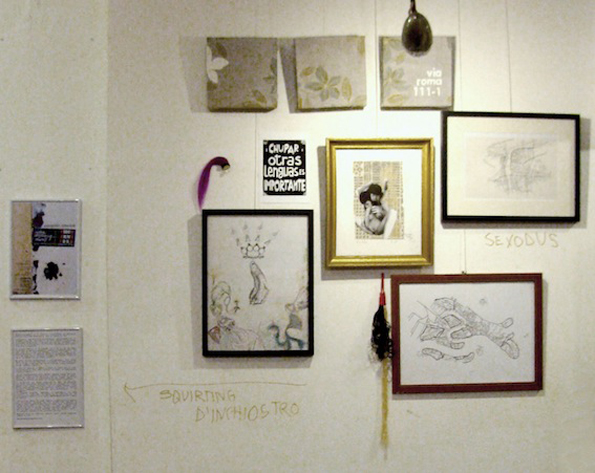
anton_ella - camouflage
Los pelos son tercos, testarudos como yo.
Siempre he odiado la escuela, o tal vez siempre me han hecho odiarla. No encontraba ninguna referencia femenina y no entendía por qué tenía que estar allí.
No habían muchas otras opciones, tuve que aprender a hacer algo práctico, tener un trabajo. He hecho un curso de esteticien de 3 años. El destino parecía ir hacia una estética que evocaba a los estándares actuales, las apariencias socialmente deseables. Pero lo que me salvó y me salva la vida es la imaginación. Hasta los 13 años tenía una amiga imaginaria, se llamaba Samantha. Quería romper, evocar sentimientos de vergüenza, rabia, choque y decidí subvertir todo para volver al mundo su repelencia. Empecé a crear alternativas a las imágenes del mercado y de la publicidad, desmantelando las teorías de la construcción del cuerpo que califican como monstruoso o anormal lo que trasborda la estética dominante.
Comencé quitando pelos, me da placer arrancar los pelos de amigos y amigas. Fue entonces hace 4 años cuando encuentro a Eva, mi vecina de casa en Barcelona.
Ella es capaz de hacer cualquier cosa con los pelos, hace posticeria de toda la vida.
Yo quiero aprender y ella me quiere enseñar.
Tardé un año en realizar mi primera peluca. El tiempo necesario para darme cuenta que no quiero trabajar con el pelo real, a menos que no me venga regalado; en el sentido que no utilizaría pelos de mujeres obligadas por su condición de pobreza a cortarse el pelo y luego venderlo.
Las personas aman sus pelos, me gustaría contar con ellos otra historia, darle una nueva vida.
Pero esta vez no los tenía, así que una parte la he comprado en una tienda afro, añadiendo aquellos que había coleccionado o puesto de un lado desde hacía tiempo.
El pelo tiene un poder social y emotivo, pero también un signo de animalidad, representa la belleza y la juventud, pero cuando viene desplazado del cuerpo es considerado misterioso e inquietante. Estoy fascinada con la idea de quitar el pelo de la cabeza y hacerlo crecer en otras partes del cuerpo para exasperar la feminidad, empecé a trabajar con extensiones pelosas en el borrador battonz kabaret: las extensiones sobresalen de los pezones, las manos, las axilas, las piernas. Este mismo principio es la base de los anillos peludos, que representan las extensiones de los pelos de los dedos, lo mismo ocurre con las corbatas.
El pelo me obsesiona, pero no soy una artista de pelos ni una peluquera.
Para comunicar y contar mi historia necesité usar este material ya que parece real y efectivo. Estos objetos y personajes peludos evocan mi infancia y mi condición de mujer.
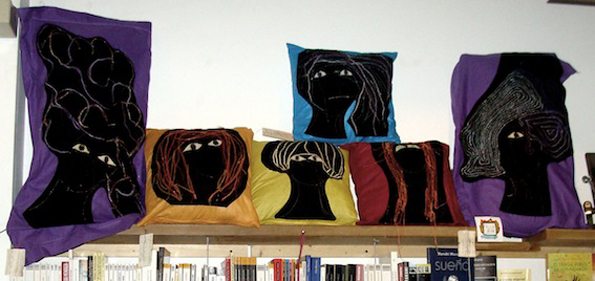
magnafranse - gemita
las posiciones ideológicas de la izquierda católica feminista italiana y de mis padres contrastaban la espectacularización de los cuerpos y de la sexualidad en el treintenio berlusconiano, proponían el moralismo y la invisibilidad de la carne como alternativa.
respondiendo también al minimalismo estético y aséptico propuesto por el capitalismo contemporáneo, magnafranse reconoce la necesidad de vivir y re-imaginar los cuerpos y las sexualidades tratando de dar significado político y visibilidad a la encarnación de los contextos, de los desplazamientos, de las historias vitales y de los encuentros.
en la ciudad donde he nacido y vivido durante 19 años, padua (noreste italiano), se encuentra una de las primeras universidades de medicina donde se hicieron disecciones anatómicas definiendo los cuerpos, su normalidad, su patologías y legitimando la metodología científica como la única capaz de entender y cuidar los cuerpos.
mi proyecto de dibujo quiere por lo tanto cuestionar desde una perspectiva feminista el poder de la anatomía clásica y su forma de representar y conservar los cuerpos.
se propone romper-destruir la tradición de la representación de los cuerpos como masculinos, universales, blancos, acotados, finitos, limitados y aislados por la frontera-piel.
por eso considera los relatos políticos de nuestras historias como parte fundacional de la anatomía de los cuerpos, situados en contextos específicos que cambian los cuerpos mismos.
utilizar el dibujo a mano empieza desde la conciencia de cómo esta práctica ha sido dominante y masculina durante siglos en europa.
al mismo tiempo recupera su potencial infantil en cuanto empieza copiando, sobreponiendo imágenes de dibujo anatómico antiguo e interfiriendo con imágines que son parte de relatos personales y tal vez compartidos.
el punto es la condición mínima del dibujo, una herramienta alcanzable, sencilla que por medio de la lentitud, la paciencia, la resistencia y el esfuerzo consigue dar forma a complejidades. es un proceso de visibilización del recorrido que hay entre un punto y una imagen y al revés, como entre una persona y la colectividad.
considera también importante ocupar los marcos, normalmente utilizados para contener el dibujo. a través del tuning se quiere romper con la invisibilidad del significado político del marco, tunearlo significa valorar este espacio intermedio.
gemita se propone crear un archivo de historias, entre autobiografía y encuentros situados.
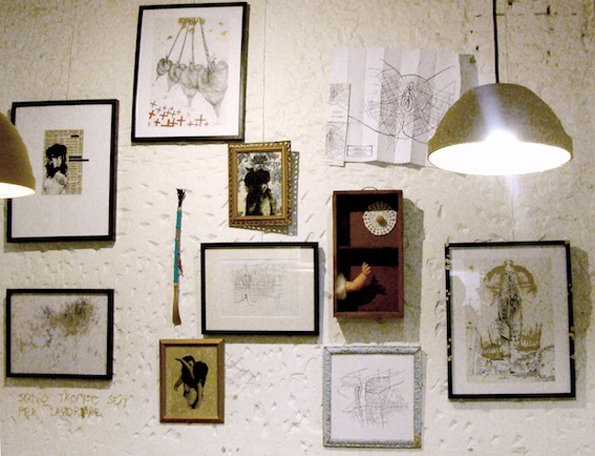
perla tempesta - coños urbanos
perla tempesta es el enfrentamiento entre presiones contrarias y contradictorias, la combinación entre ellas, entre mi vida y el estado de las cosas, y su consecuente perturbación.
las propuestas son alteraciones de lo real a través de reacciones y resignificaciones.
son a menudo espacios domésticos como a pie de calle, y otras veces espacios emocionales que acogen y se ven cambiados por otras historias extrañas respecto a las que habitualmente los atraviesan. historias que se relacionan con los lugares, los cuestionan y refuerzan la no neutralidad de cada uno de ellos.
coños urbanos es uno de los posibles cruces entre el espacio público y el sexo. es una cartografía de relaciones y contextos.
recurrir al mapa, a los planos, a los atlantes como soporte viene de los numerosos desplazamientos realizados toda mi vida. desde los aburridos trayectos en coche con los padres hasta cada excursión breve y cada estancia larga, los mapas siempre han sido compañeras de viaje.
a través de simplificaciones pactadas de complejos entramados de calles, lugares e historias me ubican en los nuevos entornos. orientarme me ha parecido siempre necesario. pero perderme ahora también lo es.
líneas sinuosas o rectas fragmentadas recorridas por mi dedo índice hasta el destino prefijado son las visualizaciones de un algo todavía desconocido.
coños urbanos son mapas emocionales que turban la objetividad del estudio urbano introduciendo en ello historias interpersonales y sexualidades no reprimidas, que practican el desplazamiento de la perspectiva genérica y universal hacia relatos micropolíticos.
perdiendo el respeto a la oficialidad y a la funcionalidad de lo ideado por urbanistas y arquitectos que huelen a despacho cerrado, de lo coordinado por mi padre y mi hermano, respectivamente aparejador e ingeniero, trazo en las ciudades nuevas calles, líneas ocultadas de historias de amor, sexo y alianzas. asuntos, estos, que determinan las maneras de cómo luego vivimos las ciudades, de cómo circulamos en ellas y de cómo nos desplazamos entre ellas.
estas nuevas ciudades son la figuración de relaciones que voy teniendo, una tensión hacia el entrelazar vínculos, hacia una colectividad afectiva en oposición al individualismo que intentaron inculcarme de todas la maneras, tanto la familia como el estado.
transformar a través de la creación artística estos mapas es representar por una parte la complejidad de la construcción de la relaciones, darle valor, perdurar y resignificar en mi imaginario también las que acaban, y por otra parte las complejidades de la construcción de las ciudades, que a veces son tan duras que casi acaban contigo.
ninguna de estas construcciones es en fin casual.
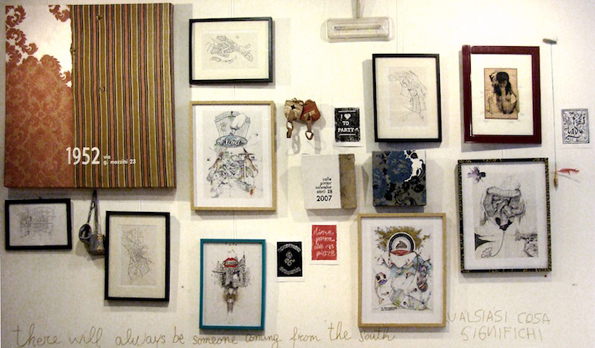
ui fak auar storis
hemos crecido en el noreste de italia, venimos de historias familiares diferentes entre ellas y juntas desafiamos el relato de la historia occidental del arte.
una entre nosotras viene de sicilia y crea principalmente a través de la escritura.
juntas nos ayudamos a cuestionarnos la dominación del norte, también de aquel que está en nosotras mismas y, a través de las relaciones, a reconocer las formas de resistencia que propone y crea el sur italia.
todas tenemos las raíces al aire y nos situamos en el desplazamiento.
no queriendo arraigarnos en ningún sitio y no pudiendo, ella, estar en españa en aquellos días, nos envió por internet una serie de frases que juntamos con otras y las que, nosotras que estábamos, escribimos en los muros de la exposición utilizando la mano izquierda y un rotulador dorado.
son estas, nos representan y representan a un mar de personas como nosotras:
non crediamo nella paura, corriamo / no creemos en el miedo, corremos
squirting d'inchiostro / squirting de tinta
sexodus
there will always someone coming from the south / siempre habrá alguien que viene desde sur
qualsiasi cosa significhi / cualquier cosa signifique
las historias de la gente están escritas en los muros
sono troppo sexy per lavorare / soy demasiado sexy para trabajar
12 diciembre - 12 enero 2014
ubik café calle litorato azorin 13
valencia
to fuck our stories puts us in the position of searching and knowing them, as one searches and knows somebody with whom one fucks.
we establish personal histories with events, places and social politics that run through us and come with us even into our beds.
in a western context where affection is constantly mediated by exploitation and domination, we attempt to displace love within translation as a practice of counter-capitalist resistence and not as a tool at the service of the european neoliberal union.
moreover, we touch through artistic practices the imagination of others, and not only one, two or more lovers.
the history of art we learnt often lacked historical and geopolitical coordinates. we consider this to be a deliberate educational omission, as it is useful above all for the integration into the eurocentric system of capitalist development, as an apparently neutral system of production that wants to be universally valid.
in ui fak auar storis we translate through artistic work our narratives, both of our bodies as well as the places where we live.
due to the fact that our stories are borderline on a geopolitical, linguistic and sexual level, they prove the banality of official history, both on the national as well as european level.
and by banality we understand the superficiality, the silences and official neutrality to which all diasporas are subjected.
having studied visual arts in venice we are conscious of the potential of absorption of the western art market, and for long time we focused on less saleable practices or on other forms of channelling visibility. however, the necessity to exhibit emerges from the urgency to recover our time and emancipate our life economies. being history of art a western homologising narrative and positioning ourselves on the borders, both real and imaginary, we no longer think that money corrupts the counter-capitalist value of what we do, but rather that we decide to take advantage of it inasmuch as it has exploited us until now.
with ui fak auar storis we bring more objectual proposals that persist in time, in contrast with the consumption even of life itself driven by the capital and in order to win once and for all!
we have started to exhibit occupying our own workplaces.
to leave shitty jobs in cafés, bars and restaurants, typical of immigrants, at this moment of reshaping of the equilibria in the european context, means to aim at economic self-determination, and once more, for creative force.
this means not only to focus on artistic work as a weapon of collective economic emancipation but also to abandon a capitalist structure that wants to see us dependent on all levels.
for this reason we believe that to carry out and imagine other forms of individual and collective economic survival, is an unavoidable part of our artistic process.
places of leisure and entertainment find desirable and profitable those creations that are politically engaged, from a perspective that is still based on the exploitation of labour, so for this reason this exhibition presently defies the venues of institutional culture.

R EST
feminism also means to make sure that the vital energies are transmitted between generations and not only due to a question of blood, but also for a struggle that transforms even lives of unknown people. this is the reason for using second hand clothes of any woman, because it carries the dreams, courage, smells, expectations and silences of all women that persist in the cloth.
sewing is a way of using a technique that my grandmother, a refugee from istria, learnt around the 1950s living in a refugee camp in bari, in the south of italy. sewing represented for her a possibility to construct for herself a form of autonomous work, at home and illegally. this had allowed her to avoid being alone at home as well as being totally dependent on the income, obtained legally, as a result of the work of her husband, also a refugee. for me my grandmother is a black woman, the history of my family's diaspora is a history only seemingly white. I am a mixed daughter, born between the west and east of europe during the years of cold war, and i trust battonz, created in the west, only when i perceive them as diasporic.
using sewing lara bia aims at eradication as a positive position. she sexualises the geopolitical order in order to represent new alliances between histories of diasporas and borders. she plays with useless objects capable of (re)educating towards diversity and connects between them those bodies which a rooted perspective prefers to see as white and separated.
collage was the only really useful way of utilising italian newspapers during the berlusconi years. at the beginning of 2000 the corruption of italian newspapers and television was obvious, so small-scale daily acts of resistance emerge (collage, stencils, painting one's hair) forming later the artistic practices and aesthetic resistances that represent the imagery of the new italian diaspora to which our stories belong.
berlusconi is the political symbol of the form of government that has made impossible our stay in italy. the act of opening a newspaper and cutting out the face of the prime minister in order to stick it later at the bottom of an ashtray of the cheapest kind gives us the possibility to achieve small satisfactions located in the everyday and later in exile. lastly, facing the homologising european anti-tobacco laws, it gives us one more reason to disobey them. it is a simple and repeatable action against every figure of power who represents the same political, democratic and decadent corruption.
individualism, success and neutrality are used in western europe as capitalist tools, thus i feel forced to beat it opting for a format of an exhibition which is collective, feminist and situated in relation to class, gender, race and origin.

merisma - Bolge
The interpretation of the model of the Bolgia came from a reading of a fragment of the note 71z of “Petroleo”, the unfinished and last work of Pier Paolo Pasolini. The description of the model represented in the text of the Bolge seemed to me an interesting figure, as it reflects the contradiction, the same contradiction which I have found in relation to desires and possibilities in the context in which I have lived for the last two years in Valencia.
The project of the Bolge was born in order to be exhibited on the walls of the place where I worked for 2 years as a cook.
Nowadays I thinks that preparing food and feeding a capitalist and consumerist mechanism has caused me to reject myself.
The little food obtained on an intellectual level became also physical as the only form of resistance. In this way the series of “double” self-portraits has become a way for me to self-portrait myself, towards the recovery of my body, my critical capabilities and a way of economic emancipation against work and a system which reduces us to zero.

anton_ella - camouflage
Hair is obstinate, stubborn as myself.
I have always hated school, or perhaps they always made me hate it. I found no female references and did not understand why I had to be there.
There were not that many other options, I had to learn to do something practical, to have a job. I did a three-year beautician course. Destiny seemed to be pointing towards aesthetics that evoked current standards and socially desirable appearances. But what saved me and still saves my life is imagination. Up to when I was 13 I had an imaginary friend called Samantha. I wanted to break, evoke feelings of shame, rage, shock and I decided to subvert everything in order to return to the world its repellency. I began to create alternatives to the images generated by the market and advertising, deconstructing the theories of the construction of the body that label as monstrous or abnormal anything that does not fit into the dominant aesthetics.
I began taking out hair, it gives me pleasure to rip out hair of friends both male and female. It was then, 4 years ago, when I met Eva, my neighbour in Barcelona.
She is capable of doing anything with hair, she has been been making wigs all her life.
I wanted to learn and she wanted to show me.
It took me a year to make my first wig. It was enough time for me to realise that I don't want to work with real hair, unless it comes to me as a gift; I mean I would not use hair of women forced by conditions of poverty to cut their hair and sell it afterwards.
People like their hair, and I would like to tell a different story with them, give them a new life.
But this time I had no hair available, so I bought some of it in an afro shop and added those that I have collected or set aside for some time.
Hair has a social and emotional power, but it is also a sign of animality; it represents beauty and youth, but when it appears displaced from the body, it is considered mysterious and disturbing. I am fascinated with the idea of moving hair from the head and make it grow in other parts of the body in order to exasperate femininity. I began to work with hair extensions in the borrador battonz kabaret: the extensions spur out of nipples, hands, armpits and legs. The same principle is at the base of the hairy rings that represent extensions of hair on the fingers, and the same happens with the ties.
Hair is an obsession of mine, but I am neither a hair artist nor a hairdresser.
In order to communicate and recount my story I needed to use a material which seems real and effective. The objects and hairy characters evoke my childhood and my condition as a woman.

magnafranse - gemita
the ideological positions of the catholic feminist left and those of my parents proposed moralism and invisibility of the flesh in contrast to the spectacularisation of the bodies and sexuality in the three berlusconi decades.
as an answer to the aesthetic and aseptic minimalism proposed by contemporary capitalism, magnafranse recognises the need to live and re-imagine bodies and sexualities while attempting to give political meaning and visibility to the embodiment of contexts, of displacements, of life histories and encounters.
in the city where I was born and lived during 19 years, padua (northeast of italy), there is one of the first medical faculties where anatomical dissections were made in order to define bodies, their normality, their pathologies, and to legitimate the scientific methodology as the only one capable to understand and care for the bodies.
my project of drawing therefore wants to question, from a feminist perspective, the power of classical anatomy and its form of representing and preserving bodies.
it proposes to break-destroy the tradition of the representation of bodies as masculine, universal, white, shaped, finite, limited and isolated by the skin-border.
for this reason it considers the political narratives of our stories as a foundational part of the anatomy of bodies, situated in specific contexts that change the bodies themselves.
the use of hand-drawing starts from the awareness of how this practice has been dominant and masculine during centuries in europe.
at the same time it recovers its childhood potential as it begins by copying, superimposing images from old anatomical drawings and interfering with images which are part of personal or perhaps shared stories.
a point is the minimal condition of drawing, an available and simple tool that by means of slowness, patience, resistance and effort, manages to give form to complexities. it is a process of granting visibility to the trajectory which exists between a point and an image and vice versa, like between a person and a collective.
it also considers important to occupy the frames, normally used in order to contain the drawing. through modification it strives to break with the invisibility of the political meaning of the frame; to modify it means to evaluate this intermediate space.
gemita proposes to create an archive of stories, between autobiography and situated encounters.

perla tempesta - coños urbanos
perla tempesta is the confrontation between contrary and contradictory pressures, the combination of these pressures, my life and the state of things and its subsequent disruption.
the proposals are alterations of the real through reactions and resignifications.
they are often domestic spaces as if on street level, and at other times emotional spaces that take in and are changed by other strange stories with respect to those that usually run through such spaces. stories that are related with the places, they question them and strengthen the non-neutrality of each one of them.
coños urbanos, urban cunts is one of the possible intersections between the public space and sex. it is a cartography of relations and contexts.
to turn to maps, plans and atlases as a medium comes from the numerous journeys undertaken for as long as I can remember. from the boring car journeys with parents to every brief trip and each long stay, maps have always been my travel companions. through agreed simplifications of complex networks of streets, places and stories locate me in new environments. orientation has always seemed to me necessary. but nowadays i find getting lost also necessary.
sinuous or straight fragmented lines along which my index finger travels to the pre-established destination are the visualisations of something yet unknown.
urban cunts are emotional maps that disrupt the objectivity of urban studies introducing in them interpersonal stories and non-repressed sexualities that practice the displacement from the generic and universal perspective to micro-political narratives.
having lost the respect for official and functional character of that which is created by urban planners and architects who smell of closed offices, of that which has been coordinated by my father and brother, a master builder and engineer respectively, i trace in cities new streets, hidden lines of stories of love, sex and alliances. these are the affairs that determine the ways in which we later live in cities, how we circulate in them and move from one to another.
these new cities are the figuration of relationships i am having, a tension towards interweaving personal ties, towards an emotional collectivity in opposition to the individualism that both the state as well as the family tried to instil in me.
to transform these maps through artistic creativity is to represent on the one hand the complexity of construction of relationships, to endow them with value, to give persistence and resignify in my imagery also those that end, and on the other hand to reflect the complexities of the construction of cities that are sometimes so hard that almost knock you out. none of these constructions are in the end coincidental.

ui fak auar storis
we grew up in the northeast of italy, we come from different family histories, and between them and together we challenge the western history of art.
one of us comes from sicily and creates mainly through writing.
together we help each other to question the domination of the north, including the north which is within ourselves, and through relationships, to recognise the forms of resistence proposed and created in the south of italy. we all have our roots out in the air and we locate ourselves in the journey. not willing to root ourselves in any place and she not being able to be in spain these days, she sent us a series of phrases which we joined with other ones and which we who were present, wrote on the walls of the exhibition location using our left had and a golden marker pen. these are the phrases, they represent us and also represent a sea of people like us:
non crediamo nella paura, corriamo / we do not believe in fear, we run
squirting d'inchiostro / ink squirting
sexodus
there will always be someone coming from the south
qualsiasi cosa significhi / whatever it means
las historias de la gente están escritas en los muros/ people's stories are written on the walls
sono troppo sexy per lavorare / i am too sexy to work
